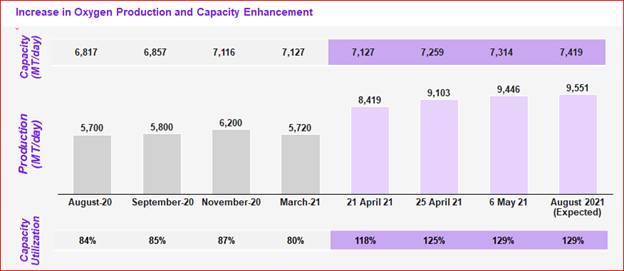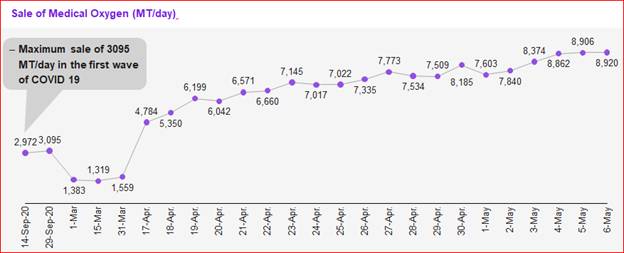In order to address the surge in demand for oxygen, the Central Government has undertakenkey measures to increase the availability, streamline the distribution and strengthen the oxygen storage infrastructure in the country. The steps undertaken focused on the entire oxygen supply chain. These include efforts for improving oxygen production, enhancing tanker availability to optimizelogistics, improving oxygen storage at thelast mile, and easing norms of procurement.

Oxygen availability has been enhanced by increase in Production Capacity and production, setting up of Pressure Swing Adsorption (PSA) Plants, import of Liquid Medical Oxygen (LMO)from Overseas, and Procurement of Oxygen Concentrators. For enhancing tanker availability to streamline transportation, Nitrogen and Argon tankers have been converted, tankers and containers have been imported, domestic manufacturing of tankersincreased, andrail and air transportation of tankers is being undertaken to reduce turn-around time.Oxygen Digital Tracking System (ODTS) has been setup of for real time monitoring, and driver availability is being enhanced with training of MHV drivers. For improving oxygen storage, number & capacity of cryogenic tankers at hospitals is being enhanced andMedicalOxygen cylinders are being procured.Relaxation of General Financial Rules (GFR) has been undertaken to enable faster procurement of critical supplies. The details regarding the measures undertaken by the Central Government on all fronts of the oxygen production, transportation, storage and infrastructure are as given hereunder.
Increase in Oxygen Production and Capacity Enhancement
Oxygen production has increased from 5700 MT/day in Aug’20 to 9,446 MT/day in May’21. The production capacity has increased from 6817 MT/ day to 7314 MT/day, and capacity utilization has gone up from 84% to 129% during this period.

Steel companies from both the public and private sectors, have stepped up efforts to meet the nation’s requirement of medical oxygen. On 4th May, 2021, the Total Liquid Medical Oxygen Production by the Steel plants was 3680.30 MT. The total LMO Supply per day was up from an average 1500-1700 MT in mid-April to 3131.84 MT on 25thApril, and further to4076.65 MT on 4th May.

Commensurate with the increase in production and demand, LMO sale in the country has also increased from about 1,300 MT/day in March’ 21 to 8,920 MT/day on 6th May.During the first wave of COVID-19, the maximum sale of 3095 MT/day of LMO was seen on 29th September, 2020. The sale of LMO grew more than five-fold from 1559 MT/day on March 31, 2021 to over 8000 MT mark by 3rd May, 2021.
Oxygen Production Capacity Enhancement Plans
Additional capacity expansion is planned in the near future to enhance oxygen production capacity. The measures in this regard include additional 70 MT/day production expected in Karnataka; Supplies from Air Separation Unitof SME sector; Jumbo Hospitals with gaseous oxygen from refineries(11,950 beds), power plants (3,850 beds), and steel plants (8,100 beds) are being set up. Supply of oxygen for non-essential industrial purposes has been prohibited w.e.f. 22nd April, 2021, resulting in ~1,000 MT of additional oxygen availability. Additional capacity expansion of 630 MT/day is also planned by Steel sector.
1,594 PSA Plants are being established to improve Oxygen Supply near demand clusters. It includes 162 plants under PM-Cares through MoHFW sanctioned in 2020, 551 under PM-Cares through MoHFW sanctioned in March 2021, 500 under PM-Cares through DRDO sanctioned on 27 Apr 2021, about 100 by Oil and Gas companies under the Ministry of Petroleum and Natural Gas, and rest by States themselves. 74 of the 162 PSA plants have been installed and the rest will be installed by June’21. 1,051 additional PSA Plants sanctioned under PM Cares Fund in March & April’21 will be commissioned in the next three months in phases.
Import of Liquid Medical Oxygen
50,000 MT of Liquid Oxygen is being imported from overseas, with orders and delivery schedule for 5,800 MT finalized. Ministry of External Affairs is actively assisting in securing sources of oxygen from abroad. To expedite the process, quotations were obtained on 21.04.21. 3 quotations have been received for 3,500 MT and approved on 21.04.21 with delivery over 3 months. In addition, 2285 MT of LMO being imported from UAE, Bahrain, Kuwait and France, a part of which has already arrived.
Procurement of Oxygen Concentrators
Procurement of 1 lakh Oxygen Concentrators has been sanctioned under PM Cares Fund on 27.04.2021. Expression of Interest was issued on 29.04.21 and Offer has been receivedfor 2,500 units. There has been good response to the tender floated by ONGC. Offers for 50,000 concentrators have been received from domestic manufacturers. Award for 9,800 units have been finalized with delivery schedule of 4,800 units on 15.05.21 and 5,000 units on 27.05.21. In addition, 55 bidders have expressed interest to supply 70,000 – 75,000 units of concentrators. Orders are being finalized and will be placed based on promised delivery schedule.
Oxygen Allocation Process
Oxygen Allocation process has been established to equitably supply oxygen to all states in line with the demand.First oxygen allocation order issued on 15.04.21 was restricted to a few states like Maharashtra, Gujarat, Delhi, Madhya Pradesh, Karnataka, etc.As the second wave of pandemic spread to other states, demand for Oxygen increased from other states. The formula of Ministry of Health and Family Welfare was used to estimate Oxygen requirement for each state in line with the active cases in the state, and maximum efforts were made to align Oxygen Allocation to the estimated demand for each state. Other factors such as availability of hospital infrastructure including ICU beds were also taken into account while finalizing allocation.
Oxygen Allocation process has continuously evolved to streamline the distribution of Oxygen in the country. Oxygen allocation to States/UTs is dynamic in nature,based on requirement as per Health Ministry norms, and consultation with States/UTs, manufacturers & other stakeholders. There is a mismatch between producing and consuming states, and equity among states to be maintained. Moreover, one-third of the production is concentrated in East India, while the ~60% of demand for oxygen is in North and South India, resulting in transportation challenges. Mapping of source and destination of oxygen has been completed to optimize transportation plan in consultation with States/UTs, manufacturers & other stakeholders.
